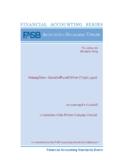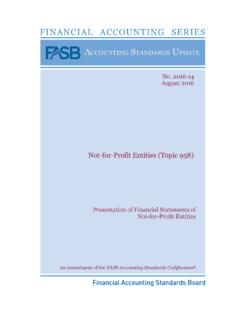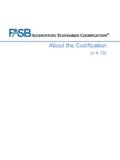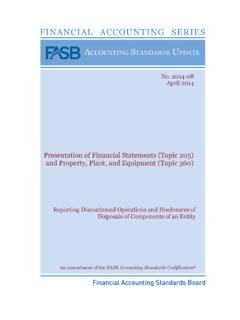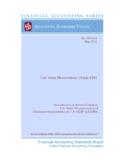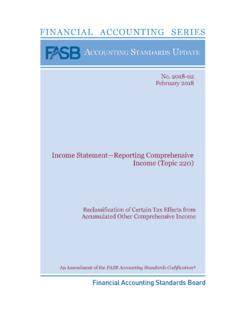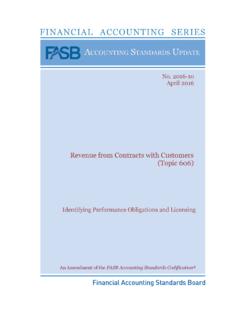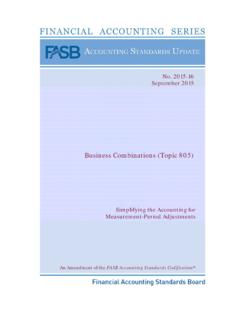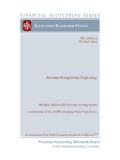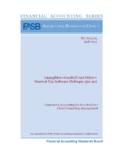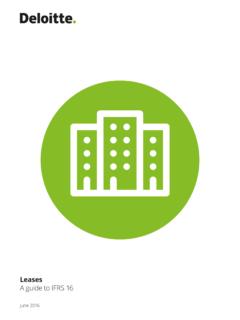Transcription of Leases (Topic 842) - FASB
1 Leases (Topic 842) No. 2016-02 February 2016 An Amendment of the FASB Accounting Standards Codification The FASB Accounting Standards Codification is the source of authoritative generally accepted accounting principles (GAAP) recognized by the FASB to be applied by nongovernmental entities. An Accounting Standards Update is not authoritative; rather, it is a document that communicates how the Accounting Standards Codification is being amended. It also provides other information to help a user of GAAP understand how and why GAAP is changing and when the changes will be effective. For additional copies of this Accounting Standards Update and information on applicable prices and discount rates contact: Order Department Financial Accounting Standards Board 401 Merritt 7 PO Box 5116 Norwalk, CT 06856-5116 Please ask for our Product Code No. ASU2016-02. FINANCIAL ACCOUNTING SERIES (ISSN 0885-9051) is published quarterly by the Financial Accounting Foundation.
2 Periodicals postage paid at Norwalk, CT and at additional mailing offices. The full subscription rate is $255 per year. POSTMASTER: Send address changes to Financial Accounting Standards Board, 401 Merritt 7, PO Box 5116, Norwalk, CT 06856-5116. | No. 426 Copyright 2016 by Financial Accounting Foundation. All rights reserved. Content copyrighted by Financial Accounting Foundation may not be reproduced, stored in a retrieval system, or transmitted, in any form or by any means, electronic, mechanical, photocopying, recording, or otherwise, without the prior written permission of the Financial Accounting Foundation. Financial Accounting Foundation claims no copyright in any portion hereof that constitutes a work of the United States Government. An Amendment of the FASB Accounting Standards Codification No. 2016-02 February 2016 Leases (Topic 842) Accounting Standards UpdateFinancial Accounting Standards Board Accounting Standards Update 2016-02 Leases (Topic 842) February 2016 CONTENTS Page Numbers Summary.
3 1 9 Amendments to the FASB Accounting Standards Codification .. 11 333 Section A Leases : Amendments to the FASB Accounting Standards Codification .. 11 185 Section B Conforming Amendments Related to Leases : Amendments to the FASB Accounting Standards Codification .. 186 333 Background Information and Basis for Conclusions .. 334 484 Amendments to the XBRL Taxonomy .. 485 1 Summary Why Is the FASB Issuing This Accounting Standards Update (Update)? The FASB is issuing this Update to increase transparency and comparability among organizations by recognizing lease assets and lease liabilities on the balance sheet and disclosing key information about leasing arrangements. To meet that objective, the FASB is amending the FASB Accounting Standards Codification and creating Topic 842, Leases . This Update, along with IFRS 16, Leases , are the results of the FASB s and the International Accounting Standards Board s (IASB s) efforts to meet that objective and improve financial reporting.
4 Leasing is utilized by many entities. It is a means of gaining access to assets, of obtaining financing, and/or of reducing an entity s exposure to the full risks of asset ownership. The prevalence of leasing, therefore, means that it is important that users of financial statements have a complete and understandable picture of an entity s leasing activities. Previous Leases accounting was criticized for failing to meet the needs of users of financial statements because it did not always provide a faithful representation of leasing transactions. In particular, it did not require lessees to recognize assets and liabilities arising from operating Leases on the balance sheet. As a result, there had been long-standing requests from many users of financial statements and others to change the accounting requirements so that lessees would be required to recognize the rights and obligations resulting from Leases as assets and liabilities.
5 Many of the criticisms associated with previous Leases guidance related to the accounting for operating Leases in the financial statements of lessees, and addressing those concerns with lessee accounting was the main focus of the Boards. As such, the Boards decided to not fundamentally change lessor accounting with the amendments in this Update. However, some changes have been made to lessor accounting to conform and align that guidance with the lessee guidance and other areas within generally accepted accounting principles (GAAP), such as Topic 606, Revenue from Contracts with Customers. Who Is Affected by the Amendments in This Update? Topic 842 affects any entity that enters into a lease (as that term is defined in this Update), with some specified scope exemptions. The guidance in this Update supersedes Topic 840, Leases . 2 How Do the Main Provisions Differ from Current Generally Accepted Accounting Principles (GAAP) and Why Are They an Improvement?
6 The main difference between previous GAAP and Topic 842 is the recognition of lease assets and lease liabilities by lessees for those Leases classified as operating Leases under previous GAAP. During redeliberations, the Board considered the feedback received throughout the project and in response to the different models proposed in the FASB Discussion Paper, Leases : Preliminary Views, the 2010 proposed Accounting Standards Update, Leases (Topic 840), and the 2013 proposed Accounting Standards Update, Leases (Topic 842). The Board decided that, consistent with all three proposals, lessees should be required to recognize the assets and liabilities arising from Leases on the balance sheet. Throughout the project, the Board consulted extensively on the approach to lease expense recognition and considered a number of alternatives. The feedback received indicated that stakeholders had various views about the economics of lease transactions.
7 The Board ultimately reached the conclusion that the economics of Leases can vary for a lessee and that those economics should be reflected in the financial statements; therefore, Topic 842 retains a distinction between finance Leases and operating Leases . The classification criteria for distinguishing between finance Leases and operating Leases are substantially similar to the classification criteria for distinguishing between capital Leases and operating Leases in the previous Leases guidance. The result of retaining a distinction between finance Leases and operating Leases is that under the lessee accounting model in Topic 842, the effect of Leases in the statement of comprehensive income and the statement of cash flows is largely unchanged from previous GAAP. Other differences between the previous Leases guidance and Topic 842 are described below. Throughout redeliberations, the Board introduced a number of simplifications from what were previously proposed; some of those simplifications were to keep the requirements in Topic 842 similar to those in the previous Leases guidance in order to reduce the cost and complexity of transition to the new guidance.
8 In addition to simplifications from the previous Leases proposals, certain aspects of lease accounting have been simplified in Topic 842 as compared with the previous Leases guidance in Topic 840. lessee Accounting The core principle of Topic 842 is that a lessee should recognize the assets and liabilities that arise from Leases . All Leases create an asset and a liability for the lessee in accordance with FASB Concepts Statement No. 6, Elements of Financial Statements, and, therefore, recognition of those lease assets and lease liabilities represents an improvement over previous GAAP, which did not require lease assets and lease liabilities to be recognized for most Leases . 3 A lessee should recognize in the statement of financial position a liability to make lease payments (the lease liability) and a right-of-use asset representing its right to use the underlying asset for the lease term. When measuring assets and liabilities arising from a lease, a lessee (and a lessor) should include payments to be made in optional periods only if the lessee is reasonably certain to exercise an option to extend the lease or not to exercise an option to terminate the lease.
9 Similarly, optional payments to purchase the underlying asset should be included in the measurement of lease assets and lease liabilities only if the lessee is reasonably certain to exercise that purchase option. Reasonably certain is a high threshold that is consistent with and intended to be applied in the same way as the reasonably assured threshold in the previous Leases guidance. In addition, also consistent with the previous Leases guidance, a lessee (and a lessor) should exclude most variable lease payments in measuring lease assets and lease liabilities, other than those that depend on an index or a rate or are in substance fixed payments. For Leases with a term of 12 months or less, a lessee is permitted to make an accounting policy election by class of underlying asset not to recognize lease assets and lease liabilities. If a lessee makes this election, it should recognize lease expense for such Leases generally on a straight-line basis over the lease term.
10 The recognition, measurement, and presentation of expenses and cash flows arising from a lease by a lessee have not significantly changed from previous GAAP. There continues to be a differentiation between finance Leases and operating Leases . However, the principal difference from previous guidance is that the lease assets and lease liabilities arising from operating Leases should be recognized in the statement of financial position. For finance Leases , a lessee is required to do the following: 1. Recognize a right-of-use asset and a lease liability, initially measured at the present value of the lease payments, in the statement of financial position 2. Recognize interest on the lease liability separately from amortization of the right-of-use asset in the statement of comprehensive income 3. Classify repayments of the principal portion of the lease liability within financing activities and payments of interest on the lease liability and variable lease payments within operating activities in the statement of cash flows.
